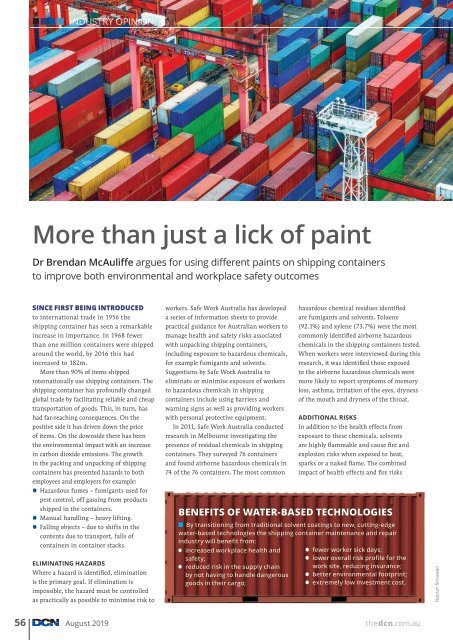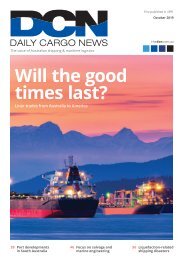DCN AUGUST Edition 2019
You also want an ePaper? Increase the reach of your titles
YUMPU automatically turns print PDFs into web optimized ePapers that Google loves.
INDUSTRY OPINION<br />
More than just a lick of paint<br />
Dr Brendan McAuliffe argues for using different paints on shipping containers<br />
to improve both environmental and workplace safety outcomes<br />
SINCE FIRST BEING INTRODUCED<br />
to international trade in 1956 the<br />
shipping container has seen a remarkable<br />
increase in importance. In 1968 fewer<br />
than one million containers were shipped<br />
around the world, by 2016 this had<br />
increased to 182m.<br />
More than 90% of items shipped<br />
internationally use shipping containers. The<br />
shipping container has profoundly changed<br />
global trade by facilitating reliable and cheap<br />
transportation of goods. This, in turn, has<br />
had far-reaching consequences. On the<br />
positive side it has driven down the price<br />
of items. On the downside there has been<br />
the environmental impact with an increase<br />
in carbon dioxide emissions. The growth<br />
in the packing and unpacking of shipping<br />
containers has presented hazards to both<br />
employees and employers for example:<br />
• Hazardous fumes – fumigants used for<br />
pest control, off gassing from products<br />
shipped in the containers.<br />
Manual handling – heavy lifting.<br />
• Falling objects – due to shifts in the<br />
contents due to transport, falls of<br />
containers in container stacks.<br />
ELIMINATING HAZARDS<br />
Where a hazard is identified, elimination<br />
is the primary goal. If elimination is<br />
impossible, the hazard must be controlled<br />
as practically as possible to minimise risk to<br />
workers. Safe Work Australia has developed<br />
a series of information sheets to provide<br />
practical guidance for Australian workers to<br />
manage health and safety risks associated<br />
with unpacking shipping containers,<br />
including exposure to hazardous chemicals,<br />
for example fumigants and solvents.<br />
Suggestions by Safe Work Australia to<br />
eliminate or minimise exposure of workers<br />
to hazardous chemicals in shipping<br />
containers include using barriers and<br />
warning signs as well as providing workers<br />
with personal protective equipment.<br />
In 2011, Safe Work Australia conducted<br />
research in Melbourne investigating the<br />
presence of residual chemicals in shipping<br />
containers. They surveyed 76 containers<br />
and found airborne hazardous chemicals in<br />
74 of the 76 containers. The most common<br />
hazardous chemical residues identified<br />
are fumigants and solvents. Toluene<br />
(92.1%) and xylene (73.7%) were the most<br />
commonly identified airborne hazardous<br />
chemicals in the shipping containers tested.<br />
When workers were interviewed during this<br />
research, it was identified those exposed<br />
to the airborne hazardous chemicals were<br />
more likely to report symptoms of memory<br />
loss, asthma, irritation of the eyes, dryness<br />
of the mouth and dryness of the throat.<br />
ADDITIONAL RISKS<br />
In addition to the health effects from<br />
exposure to these chemicals, solvents<br />
are highly flammable and cause fire and<br />
explosion risks when exposed to heat,<br />
sparks or a naked flame. The combined<br />
impact of health effects and fire risks<br />
BENEFITS OF WATER-BASED TECHNOLOGIES<br />
By transitioning from traditional solvent coatings to new, cutting-edge<br />
water-based technologies the shipping container maintenance and repair<br />
industry will benefit from:<br />
• increased workplace health and<br />
fewer worker sick days;<br />
safety;<br />
• lower overall risk profile for the<br />
• reduced risk in the supply chain<br />
work site, reducing insurance;<br />
by not having to handle dangerous<br />
better environmental footprint;<br />
goods in their cargo; • extremely low investment cost.<br />
Natnan Srisuwan<br />
56 August <strong>2019</strong><br />
thedcn.com.au
















